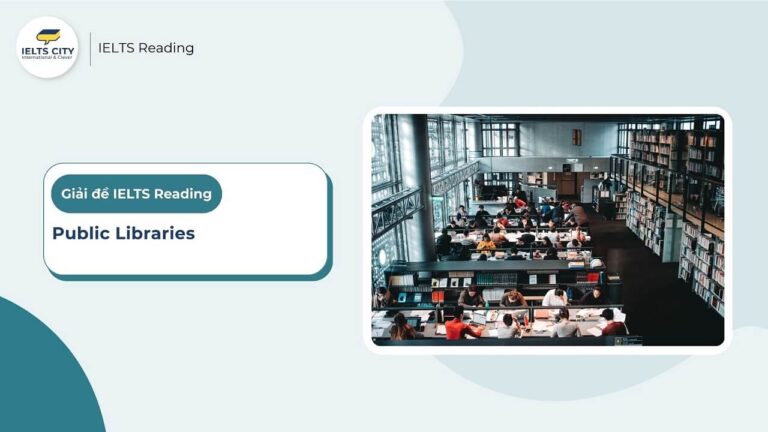Việc nắm vững các kỹ thuật làm bài Table Completion sẽ giúp sĩ tử IELTS dễ dàng hơn trong việc hoàn thành phần thi Reading một cách chính xác và hiệu quả. Trong bài viết này, IELTS CITY sẽ đi sâu vào các bước thực hiện bài Table completion ielts reading và các lỗi thường gặp, một số mẹo hữu ích để tối ưu điểm số cho dạng câu hỏi này nhé!

Nội dung chính
Toggle1. Table Completion là gì?
Table Completion là dạng bài IELTS Reading tuy không phổ biến bằng các dạng như True/False/Not Given hay Multiple-choice questions, nhưng cũng thường xuyên xuất hiện trong bài thi Reading của sĩ tử IELTS.
Dạng đề này yêu cầu thí sinh điền từ vào chỗ trống trong bảng tóm tắt thông tin bài đọc. Thí sinh cần tìm các từ khóa phù hợp để hoàn thành bảng. Dạng này thường xuất hiện trong Passage 2 và Passage 3, các bài đọc có nhiều thông tin chi tiết, sự kiện hoặc dữ liệu cụ thể, phù hợp với việc trình bày dưới dạng bảng.
Đặc điểm nhận dạng đề bài:
- Bài đọc cung cấp một bảng chứa các thông tin chưa hoàn chỉnh, với các ô trống cần điền và một tiêu đề tóm tắt nội dung chính của bảng dữ liệu.
- Hướng dẫn thường yêu cầu điền một từ hoặc một số từ nhất định từ bài đọc.
- Các từ cần điền thường là danh từ, động từ, hoặc số liệu. Đôi khi có thể là cụm từ ngắn.

(Nguồn: Cambridge 17: Test 1)
2. Các bước làm bài Table Completion trong IELTS Reading
Bước 1: Đọc kỹ yêu cầu của đề bài
Đặc biệt chú ý xem đề yêu cầu điền bao nhiêu từ. Đây là bước quan trọng vì nếu điền nhiều hơn số từ được yêu cầu, câu trả lời sẽ bị tính sai.
Ví dụ: Trong bài trên, đề bài yêu cầu viết MỘT CHỮ (ONE WORD ONLY).
Bước 2: Xác định các từ khóa xung quanh các ô trống trong bảng
Các từ khóa này có thể là các năm, sự kiện, hoặc chi tiết trong bảng. Ở bước này, thí sinh nên vận dụng các từ hoặc cụm đồng nghĩa mà mình biết cho các từ khóa chính trong câu:
Ví dụ:
The problem
- The 1. _____________________ of London increased rapidly between 1800 and 1850.
Trong phần này, từ khóa chính sẽ là: London, increased rapidly, 1800-1850
Từ đồng nghĩa của các từ này sẽ bao gồm:
- 1800-1850 : Early to mid-19th century; the early 1800s to mid-1800s, in the first half of 1800s
- increased rapidly: soared, escalated, proliferated in number, grew significantly
Bước 3: Xác định loại từ cần điền
Dựa vào ngữ cảnh của các ô trống, dự đoán loại từ cần điền (danh từ, động từ, tính từ, hoặc trạng từ) và những từ có thể được cho dựa vào ngữ cảnh. Điều này sẽ giúp giới hạn phạm vi từ cần tìm, giúp điền đáp án chính xác hơn.
Ví dụ:
The 1. _____________________ of London increased rapidly between 1800 and 1850.
Dựa vào vị trí của chỗ trống trong câu, từ cần điền là danh từ vì nó đứng sau “The” và trước “of London”, chỉ một thứ thuộc về London. Từ này sẽ là đối tượng tăng lên nhanh chóng trong giai đoạn 1800-1850. => Có thể từ được cho sẽ là population hoặc economy.
Bước 4: Đọc kỹ tiêu đề của cột hoặc dòng
Nếu bảng có tiêu đề cột hoặc dòng, hãy đọc kỹ chúng. Tiêu đề thường cung cấp manh mối quan trọng về nội dung cần điền và giúp bạn nhanh chóng xác định đoạn văn liên quan trong bài đọc.
Ví dụ: tiêu đề nói về problems (vấn đề tiêu cực), như vậy, thí sinh cần tập trung tìm từ khóa ở những đoạn liên quan về các vấn đề rắc rối hoặc tiêu cực.
Bước 5: Dùng tiêu đề và từ khóa đã xác định để tìm ra đoạn văn chứa từ khóa đã phân tích
Sau khi tìm được đoạn văn có liên quan, đọc kỹ đoạn đó và đối chiếu với yêu cầu của bảng. Chọn từ hoặc cụm từ phù hợp nhất để điền vào chỗ trống.
Ví dụ:
The problem
- The 1. _____________________ of London increased rapidly between 1800 and 1850.
In the first half of the 1800s, London’s population grew at an astonishing rate, and the central area became increasingly congested. In addition, the expansion of the overground railway network resulted in more and more passengers arriving in the capital. However, in 1846, a Royal Commission decided that the railways should not be allowed to enter the City, the capital’s historic and business centre. The result was that the overground railway stations formed a ring around the City. The area within consisted of poorly built, overcrowded slums and the streets were full of horse-drawn traffic. Crossing the City became a nightmare. It could take an hour and a half to travel 8 km by horse-drawn carriage or bus. Numerous schemes were proposed to resolve these problems, but few succeeded.
Trong câu này: In the first half of the 1800s, London’s population grew at an astonishing rate, and the central area became increasingly congested.
In the first half of the 1800s = between 1800 and 1850
grew at an astonishing rate = increased rapidly
London’s population = The ____of London
=> Câu trả lời: population
Bước 6: Kiểm tra lại
Sau khi điền từ vào bảng, hãy kiểm tra lại các từ đã điền để đảm bảo rằng chúng phù hợp với yêu cầu về ngữ pháp, chính tả và số lượng từ.
3. Các lỗi thường gặp khi làm bài Table Completion
- Điền quá nhiều từ: Nhiều thí sinh không chú ý đến yêu cầu về số lượng từ nên điền sai. Ví dụ, đề yêu cầu “no more than two words” nhưng thí sinh lại điền ba từ.
- Không hiểu đúng từ khóa: Một số thí sinh hiểu sai từ khóa, dẫn đến tìm sai đoạn văn hoặc thông tin.
- Điền thông tin không khớp với ngữ pháp của câu: Ví dụ, điền động từ khi yêu cầu là danh từ.
- Sử dụng từ không có trong bài đọc: Điền từ dựa trên kiến thức riêng thay vì lấy từ bài đọc.
4. Bài tập dạng Table Completion trong IELTS Reading
The development of the London underground railway
In the first half of the 1800s, London’s population grew at an astonishing rate, and the central area became increasingly congested. In addition, the expansion of the overground railway network resulted in more and more passengers arriving in the capital. However, in 1846, a Royal Commission decided that the railways should not be allowed to enter the City, the capital’s historic and business centre. The result was that the overground railway stations formed a ring around the City. The area within consisted of poorly built, overcrowded slums and the streets were full of horse-drawn traffic. Crossing the City became a nightmare. It could take an hour and a half to travel 8 km by horse-drawn carriage or bus. Numerous schemes were proposed to resolve these problems, but few succeeded.
Amongst the most vocal advocates for a solution to London’s traffic problems was Charles Pearson, who worked as a solicitor for the City of London. He saw both social and economic advantages in building an underground railway that would link the overground railway stations together and clear London slums at the same time. His idea was to relocate the poor workers who lived in the inner-city slums to newly constructed suburbs, and to provide cheap rail travel for them to get to work. Pearson’s ideas gained support amongst some businessmen and in 1851 he submitted a plan to Parliament. It was rejected, but coincided with a proposal from another group for an underground connecting line, which Parliament passed.
The two groups merged and established the Metropolitan Railway Company in August 1854. The company’s plan was to construct an underground railway line from the Great Western Railway’s (GWR) station at Paddington to the edge of the City at Farringdon Street — a distance of almost 5 km. The organisation had difficulty in raising the funding for such a radical and expensive scheme, not least because of the critical articles printed by the press. Objectors argued that the tunnels would collapse under the weight of traffic overhead, buildings would be shaken and passengers would be poisoned by the emissions from the train engines. However, Pearson and his partners persisted.
The GWR, aware that the new line would finally enable them to turn trains into the heart of the metropolis, invested almost £250,000 in the scheme. Eventually, after a five-year period, all the necessary funds were raised. The chosen route ran beneath existing roads to minimise the expense of demolishing buildings. Originally scheduled to be completed in 21 months, the construction of the underground line took three years. It was built just below street level using a technique known as ‘cut and cover’. A trench about ten metres wide and six metres deep was dug, and the sides temporarily held up with timber beams. Brick walls were then constructed, and finally a brick arch was added to create a tunnel. A two-metre-deep layer of soil was laid on top of the tunnel and the road above rebuilt.
The Metropolitan line, which opened on 10 January 1863, was the world’s first underground railway. On its first day, almost 40,000 passengers were carried between Paddington and Farringdon, the journey taking about 18 minutes. By the end of the Metropolitan’s first year of operation, 9.5 million journeys had been made.
Even as the Metropolitan began operation, the first extensions to the line were being authorised; these were built over the next five years, reaching Moorgate in the east of London and Hammersmith in the west. The original plan was to pull the trains with steam locomotives, using firebricks in the boilers to provide steam, but these engines were never introduced. Instead, the line used specially designed locomotives that were fitted with water tanks in which steam could be condensed. However, smoke and fumes remained a problem, even though ventilation shafts were added to the tunnels.
Despite the extension of the underground railway, by the 1880s, congestion on London’s streets had become worse. The problem was partly that the existing underground lines formed a circuit around the centre of London and extended to the suburbs, but did not cross the capital’s centre. The ‘cut and cover’ method of construction was not an option in this part of the capital. The only alternative was to tunnel deep underground.
Although the technology to create these tunnels existed, steam locomotives could not be used in such a confined space. It wasn’t until the development of a reliable electric motor, and a means of transferring power from the generator to a moving train, that the world’s first deep-level electric railway, the City & South London, became possible. The line opened in 1890, and ran from the City to Stockwell, south of the River Thames. The trains were made up of three carriages and driven by electric engines. The carriages were narrow and had tiny windows just below the roof because it was thought that passengers would not want to look out at the tunnel walls. The line was not without its problems, mainly caused by an unreliable power supply. Although the City & South London Railway was a great technical achievement, it did not make a profit. Then, in 1900, the Central London Railway, known as the ‘Tuppenny Tube’, began operation using new electric locomotives. It was very popular and soon afterwards new railways and extensions were added to the growing tube network. By 1907, the heart of today’s Underground system was in place.

Giải thích chi tiết:
1. Dòng “move people to better housing in the ____.” Từ khóa: move people, better housing. Tiêu đề: proposed solutions (các phương án được đề xuất)
- Trong đoạn văn số 2 có câu “relocate the poor workers… to newly constructed suburbs.” => Đáp án: suburbs.
2. Dòng “A number of ____ agreed with Pearson’s idea.” Từ khóa: agreed with Pearson’s idea.
- Trong đoạn văn số 2 có câu “Pearson’s ideas gained support amongst some businessmen.” => Đáp án: businessmen.
3. Dòng “The company initially had problems getting the ____ needed for the project.” Từ khóa: problems, needed for the project.
- Trong đoạn văn số 3 có câu “The organisation had difficulty in raising the funding.” => Đáp án: funding.
4. Dòng “Negative articles about the project appeared in the ____.” Từ khóa: Negative articles.
- Trong đoạn văn số 3 có câu “critical articles printed by the press.” => Đáp án: press.
5. Dòng “With the completion of the brick arch, the tunnel was covered with ____.” Từ khóa: the tunnel was covered with.
- Trong đoạn văn số 4 có câu “the tunnel was covered with a layer of earth.” => Đáp án: earth.
Nhìn chung, dạng bài Table Completion trong IELTS Reading đòi hỏi sự nhạy bén trong việc xác định thông tin liên quan từ văn bản và kỹ năng điền đúng thông tin vào bảng một cách chính xác. Hy vọng rằng qua bài viết này, bạn đã nắm rõ quy trình và những chiến lược cần thiết để tự tin đối mặt với dạng bài Table Completion trong kỳ thi IELTS Reading. Chúc bạn học tập và ôn luyện hiệu quả để đạt được mục tiêu điểm số mong muốn trong kỳ thi IELTS sắp tới.





















